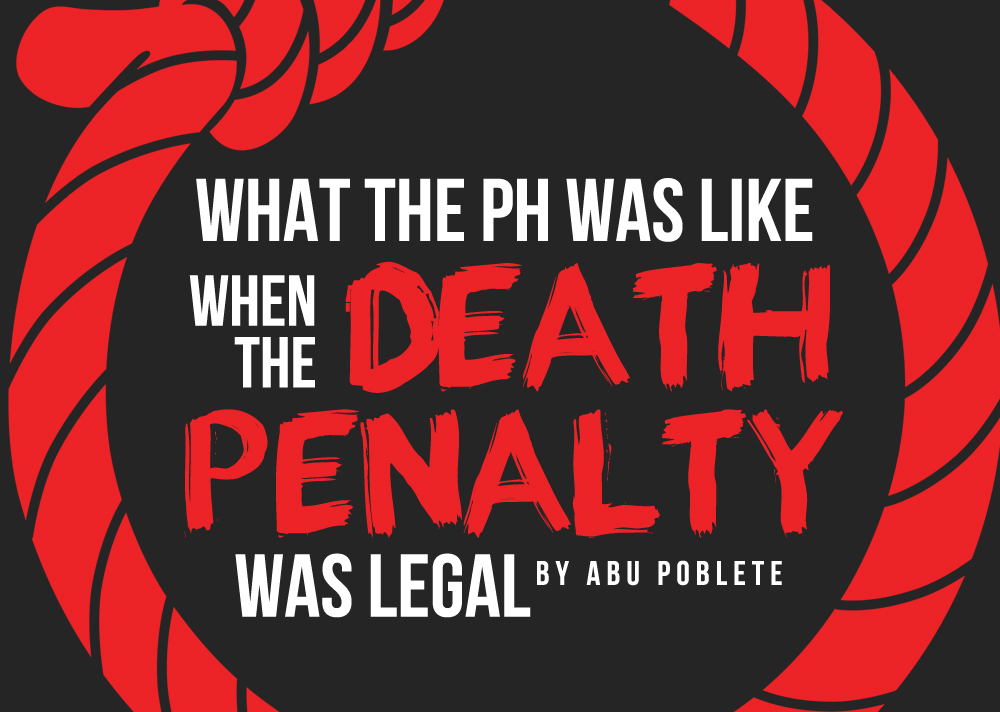What the PH was Like When the Death Penalty was Legal
Jan 13, 2016 • Abu Poblete

Jan 13, 2016 • Abu Poblete

When the Indonesian Government sentenced Filipino Mary Jane Veloso to death for smuggling 2.6 kilograms of heroin into their country in 2015, the country went up in arms. Although human rights groups and even President Noynoy Aquino himself worked to achieve Veloso’s reprieve last April 2015, the battle to free the OFW still has a long way to go.
Some may think the death penalty is an archaic punishment for criminals, it is still very much alive in a number of countries. Just in the Asia Pacific countries like China, India, Japan, Malaysia, Singapore, Taiwan, Thailand, and of course Indonesia, among others, retain the death penalty. In the Philippines, it has been 17 years since someone was lawfully executed. Here’s a timeline of the history of capital punishment in the country.
Along with everything else the Spanish brought to the Filipinas was the 1848 Spanish Codigo Penal–a law allowing capital punishment to be imposed on locals who went against the Spanish government. Despite around 1,700 death sentences, however, only 46 were executed.
The methods used then to execute criminals included burning, decapitation, drowning, flaying, garrote, hanging, shooting and stabbing.
And yes, this was the era where some of our national heroes were executed–GOMBURZA, Magat Salamat and Jose Rizal.
When the Americans “won” the Philippines in the 1898 Battle of Manila against the Spanish occupation, they continued some of the laws from the Codigo panel. The death penalty was one of the things they adopted. The Americans revised the Codigo and added treason, parricide, piracy, kidnapping, murder, rape and robbery with homicide as capital offenses that result in the death penalty.
The Americans’ grounds of prosecution were those who went against the laws the US government had implemented in the country. Filipinos were under the Sedition Law, which was against those who advocated Philippine independence from American authority. The Brigandage Act was also legalized, which prohibited Filipinos from taking up arms or moving against the Americans. They also legalized the Reconcentration Act to disallow rebels from hiring innocent citizens as battle support. Another law they enacted was the Flag Law that forbade anyone from using the Philippine flag, banner, symbol or anthem to symbolize or represent nationalist parties. Anyone who went against these laws were legally subjected to death, among other punishments.
The electric chair was the chosen method of execution used by the American government to those who opposed them.
During the Japanese era (which lasted from 1942 to 1945), there were no recorded capital punishment cases but the extrajudicial killings by the Japanese authority has been estimated at around one million casualties. It’s important, at this point, to also remind you of the physical destruction the whole country suffered during the Japanese regime–entire cities destroyed to their roots. The occupation ended on September 2, 1945 after a long battle between the Filipinos, Americans and Japanese.
During the regime of Ferdinand Marcos, the number of those executed rose. The crimes that merited capital punishment blossomed to 24: arson, subversion, illegal fishing, embezzlement, cattle rusting, possession of firearms, hijacking, drug-related offenses and unlawful possession of firearms, among others.
A total of 31 executions were conducted during the Marcos era–a number which doesn’t even compare to the 759 involuntary disappearances, 800 illegal abductions, 35,000 torture victims, 70,000 incarcerated and 3,257 victims of extrajudicial killings (that we know of).
Halfway through Marcos’ regime, the electric chair was still the chosen means of execution. Death by firing squad was the next most-used method.
Pages: 1 2
Abu is a fangirl by day, and a sleeping fangirl by night. She is mostly seen on Twitter which she considers her first home even though she loathes with all her being its cancel culture (We can all grow and learn guys!). She ranks as the Philippines' number one Modern Family fan in QuizUp. She's a cool girl (she also wrote this write-up).
Input your search keywords and press Enter.
